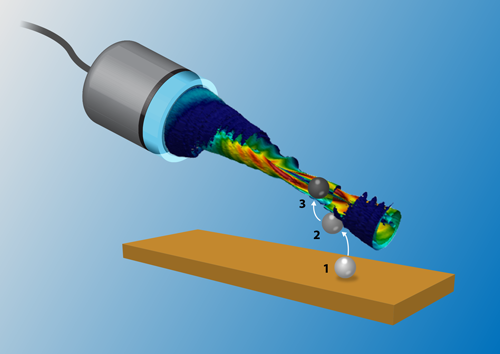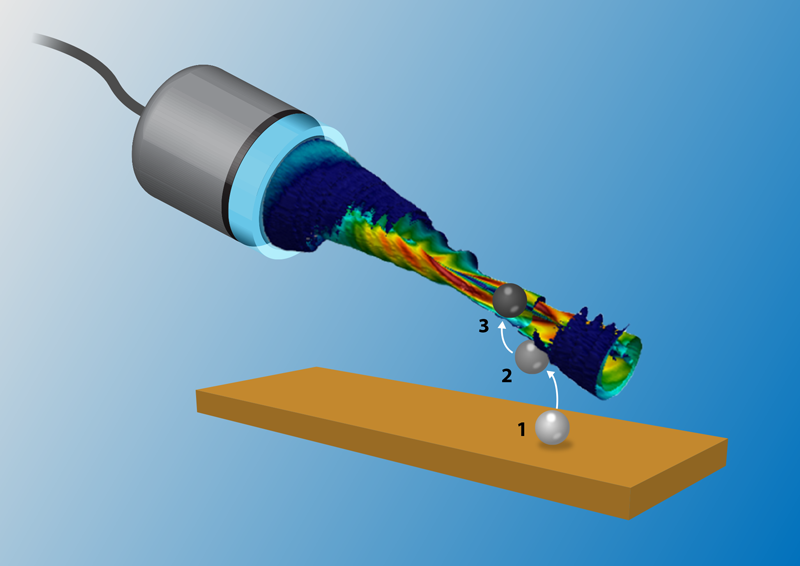A One-Sided View of Acoustic Traps
Biotechnology and automated assembly often involve the manipulation of tiny particles, such as cells, small organisms, and other submillimeter objects. In many cases, this manipulation needs to be performed without touching the particles. Yet doing so accurately is a challenge, particularly in biocompatible setups. Two groups, one in France, the other in the UK, have now made a significant step forward in the remote manipulation of particles using sound waves. Following different approaches, they have demonstrated an acoustic trap that levitates and constrains one or more particles in three dimensions using a single acoustic source [1, 2]. Compared to acoustic traps that require multiple sources or reflecting elements, these new “single beam” traps offer greater flexibility because they can access a collection of particles from just one side. This capability could, in the long term, help to maneuver cells or tissue in situ.
Optical trapping is the dominant method of manipulating small particles without contact. But traps based on sound waves, as opposed to light, can trap larger particles (or collections of particles) with stronger forces and do not require the particles to have particular optical properties or to be accessible via an optically transparent path. In addition, ultrasound waves can be less disruptive to biomaterials than light.
When an acoustic wave interacts with a particle, it exerts both an oscillatory force and a much smaller steady-state “radiation” force. This latter force is the one used for trapping and manipulation. Radiation forces are generated by the scattering of a traveling sound wave, or by energy gradients within the sound field. These gradients result from variations in the pressure and in the acoustic particle velocity—that is, the oscillatory velocity of the surrounding medium caused by the acoustic field. For particles much smaller than the sound wavelength, energy gradients tend to produce the largest radiation forces, drawing particles to low/high regions of pressure and velocity (depending on the particles’ relative density/stiffness). Thus a beam with suitably shaped energy gradients can be used to trap or move a particle.
“Acoustic tweezers”—as these shaped sound fields are sometimes called [3]—have been used to trap and manipulate particles in gases [4] and liquids [5]. Recently, the use of large arrays of acoustic transducers has allowed researchers to control the movement of multiple particles independently [6]. But all of these cases have required an acoustic source on one side of the trap and a second source or a reflector on the other. Traps using a single source have been prepared using sound waves with wavelengths much smaller than the trapped objects [7]. These single-source schemes, however, required a restraining film to ensure that radiation forces from the traveling wave did not kick out the particle along the beam axis.
In contrast, the new experimental demonstrations by the groups in France and the UK involve sound waves that are larger than the trapped particle. This means energy gradients are the dominant trapping mechanism. But radiation forces from scattering are still a problem. Specifically, when two counterpropagating acoustic beams form a stationary wave, their respective contributions to radiation forces roughly cancel. This cancellation doesn’t occur in single-sided traps, which therefore need negative gradient forces to draw the particle back to the transducer—a significant design challenge.
Another complication with single-sided traps comes from the nature of the gradient forces. Most particles of interest are stiffer (less compressible) and denser than the fluid that surrounds them, so they will be attracted to regions of low acoustic pressure and high acoustic velocity. These two regions coincide in a standing wave made from plane waves, ensuring a single stable trapping region for the particle. For single-sided systems, however, researchers have typically used a focusing technique to produce the required energy gradients in the acoustic beam. Unfortunately, such focusing generates a point where both acoustic pressure and velocity are high on the beam’s axis, and this makes the stable trapping of most materials impossible.
The two new demonstrations have overcome these obstacles in different ways. Diego Baresch of the Pierre and Marie Curie University, France, and colleagues use a transducer array and a wave-front synthesis technique to generate what’s called an acoustic vortex beam (Fig. 1). Such a beam has an acoustic pressure null on its axis [8], which suppresses the scattering that leads to repulsion from the axis of a simple focused beam and provides a strong lateral trap. The researchers then focus the beam with an acoustic lens to create a trap along the beam’s axis.
The team led by Sriram Subramanian and Bruce Drinkwater at the University of Bristol, UK, avoided the need for an acoustic lens by synthesizing the acoustic field with an array of transducers that they controlled with an optimization algorithm. Once again, the success of their approach is to create traps that simultaneously combine the required lateral and axial energy gradients with a low-pressure amplitude at the trap position. The authors dub this a “silent” acoustic trap. Because their trap is lens-less they can move the trap position—and hence particles—simply by controlling the inputs to the array. This has also allowed them to investigate trap topologies other than vortex traps. For example, they have created a so-called bottle trap that provides stronger trapping forces along the beam axis but at the expense of weaker trapping forces perpendicular to the axis.
The main interest in these new traps will likely be biomedical applications. The acoustic tweezers can be used to trap, hold, and move cells, and to collect them in a controlled environment, providing a noncontact alternative to micropipettes. Further developments of the technology might allow trapping and manipulation of particles in the body, enabling, for example, drug capsules to be held at specific points. Here, the new schemes would allow researchers to access the surface of soft tissue from one side, without needing the acoustic energy to penetrate tissue from two sides. The Bristol team speculates that the acoustic fields might be a useful tool for performing microsurgery.
The restraining forces demonstrated by these groups have often been referred to as “tractor beams,” a term originating from science fiction. Although these new schemes can’t be used to capture spacecraft, their future implementation on a microscopic scale is no less intriguing. And it’s quite possible that acoustic tweezers could be used within these spacecraft to hold and control particles in zero gravity.
This research is published in Physical Review Letters and Nature Communications.
References
- D. Baresch, J.-L. Thomas, and R. Marchiano, “Observation of a Single-Beam Gradient Force Acoustical Trap for Elastic Particles: Acoustical tweezers,” Phys. Rev. Lett. 116, 024301 (2016).
- A. Marzo, S. A. Seah, B. W. Drinkwater, D. R. Sahoo, B. Long, and S. Subramanian, “Holographic Acoustic Elements for Manipulation of Levitated Objects,” Nature Commun. 6, 8661 (2015).
- J. Wu, “Acoustical Tweezers,” J. Acoust. Soc. Am. 89, 2140 (1991).
- D. Foresti and D. Poulikakos, “Acoustophoretic Contactless Elevation, Orbital Transport and Spinning of Matter in Air,” Phys. Rev. Lett. 112, 024301 (2014).
- H. Bruus, J. Dual, J. Hawkes, M. Hill, T. Laurell, J. Nilsson, S. Radel, S. Sadhal, and M. Wiklund, “Forthcoming Lab on a Chip Tutorial Series on Acoustofluidics: Acoustofluidics—Exploiting Ultrasonic Standing Wave Forces and Acoustic Streaming in Microfluidic Systems for Cell and Particle Manipulation,” Lab Chip 11, 3579 (2011).
- C. R. P. Courtney, C. E. M. Demore, H. Wu, A. Grinenko, P. D. Wilcox, S. Cochran, and B. W. Drinkwater, “Independent Trapping and Manipulation of Microparticles Using Dexterous Acoustic Tweezers,” Appl. Phys. Lett. 104, 154103 (2014).
- J. Lee, S. Y. Teh, A. Lee, H. H. Kim, C. Lee, and K. K. Shung, “Single Beam Acoustic Trapping,” Appl. Phys. Lett. 95, 073701 (2009).
- P. L. Marston, “Radiation Force of a Helicoidal Bessel Beam on a Sphere,” J. Acoust. Soc. Am. 125, 3539 (2009).





